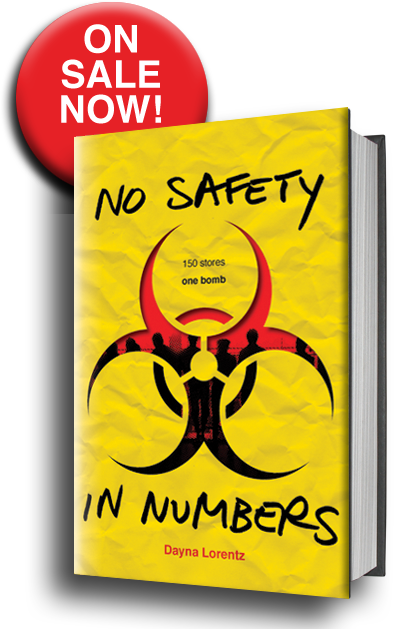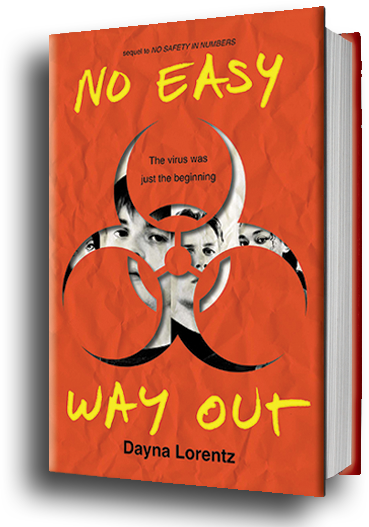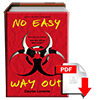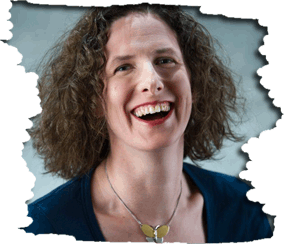No escape. No place to hide. No safety in numbers.
"A whopping and disturbing cliffhanger serves as the conclusion.
Readers will anxiously await the sequel."
—Kirkus
Read the author Q&A for exclusive behind the scenes material!
A. No Easy Way Out and No Safety in Numbers are disaster books and
also science fiction -so what kind of research did you do to make sure
the science was accurate? (I might rephrase this to be smoother, but
you get the gist)
I should note that whenever the science didn't suit the purposes of the
story, the science lost. That said, I did a ton of research to try to make
sure that everything in the story is at least plausible.
For the majority my medical research, I relied on a very good friend who is
a doctor and a lover of YA literature. In the beginning when I was figuring
everything out, we had lots of morbid conversations like, "But would
Ebola kill people too quickly?" and "The Black Plague is curable so it's not
going to work, right?" I basically bounced every disease and toxin on the
CDC's bioterrorism website off her and we weighed the pros and cons of
using each to wreak havoc on the Shops at Stonecliff.
To better understand how people might respond to situations of outbreak
and quarantine, I studied the Spanish Flu pandemic of 1918. I was blown
away by my research into this incident. In school, I remember learning
little to nothing about it, and yet more Americans died during this
pandemic than were killed in combat in all of the wars of the 20th Century.
The flu devastated whole towns in America, and led to the breakdown of
normal social interaction-people wore masks, were forbidden to shake
hands, and businesses and schools closed.
I also looked at how the government handled a more recent crisis,
Hurricane Katrina, and tried to extrapolate what emergency management
agencies learned from that quagmire and how they would improve or fail
to improve their response.
When confronted with technical issues about which I had no knowledge, I
used experts or researched things on my own. I took a self-defense class
to learn about realistic physical attacks and defense. I watched a lot of
episodes of Mythbusters to learn about weapons and what can be made
into a weapon. My father designed card-key access security systems and
closed-circuit surveillance systems in his former life, and he helped me
figure out how those worked and could be made to not work. A good
friend of mine is a serious gamer, and he helped me understand the
worlds of online and console gaming.
B. What surprised you most (or scared you most) in your research of the
flu?
Everything about the flu scares me. Maybe the first terrifying moment
was when my medical expert friend told me, "Why do you need a bomb?
Just have a sick person walk through the mall and cough on someone."
This is all you need to cause a pandemic.
Second to that was how easy it would be to create a super deadly and
infectious strain of the flu. Normally, a flu strain either has a high
morbidity rate or a high rate of infection-it is rare for a flu to be both
highly contagious and deadly. But it is not hard to engineer such a flu
through a genetic shift by crossing species. In fact, all you need to do is
infect a sick pig with an avian flu, or a sick bird with a swine flu, or a sick
person with either and see what happens. Worse, a deadly flu can mutate
into a deadly and contagious form simply through its transmission from
one patient to the next, as was revealed by Dutch scientists last fall.
Next was discovering just how bad the symptoms of the flu can get. In
researching what happened to people infected with the Spanish Flu, I was
horrified to learn that some people died within twelve hours of showing
symptoms. People suffered from raging fevers, delirium, and bleeding
from the eyes, nose, ears, and mouth as their mucous membranes
hemorrhaged and lungs filled with fluid. Because their extremities were
deprived of oxygen, people's skin would develop dark spots, and their
ears, fingers, and toes a bluish cast.
C. What changes to the text were necessarily in order for the science to
work?
It was more that I bent the science to fit my story than that I changed my
story to fit the text. For example, the Stonecliff flu has a very short
incubation period, an unusually high mortality rate, and for younger
people, a very short recovery period. This was necessary so that I could
infect characters with the flu without knocking them out for the entire
novel or trilogy. The story, however, was informed by the science. When
an idea of mine failed to pass the "smell test"-is it completely rotten,
a/k/a implausible?-with my experts, I rethought that plot point.



 READ A
READ A 


 Dayna Lorentz grew up in northeastern New Jersey surrounded by no less than four malls and though
never literally trapped inside one, it sometimes felt that way nonetheless. She holds an MFA in Creative Writing and Literature from Bennington College and is the author of the Dogs of the Drowned City series, to be published by Scholastic in spring 2012. A former attorney, Dayna is now a full time writer and lives with her husband, daughter, dogs, and cat in Vermont.
Dayna Lorentz grew up in northeastern New Jersey surrounded by no less than four malls and though
never literally trapped inside one, it sometimes felt that way nonetheless. She holds an MFA in Creative Writing and Literature from Bennington College and is the author of the Dogs of the Drowned City series, to be published by Scholastic in spring 2012. A former attorney, Dayna is now a full time writer and lives with her husband, daughter, dogs, and cat in Vermont.